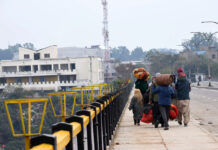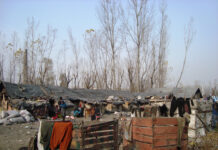Preserving heritage is enriching the soul of a culture, ye there is so much citizens and governments tend to often ignore. P A Mushtaq traces his way to the only mausoleum built by the Mughals to a Kashmiri in old city Srinagar. It had been forgotten and crumbling but fortunately now whatever is left of it is being restored and preserved.
A walk into a seemingly insignificant and nondescript lane, facing river Jhelum in downtown Srinagar’s Nawakadal area, leads to a forgotten treasure. A small brick, lime, carved stones and marble structure with falling walls and encroached land opens up a unique piece of Mughal-era architecture for historians and heritage conservationists in particular, and the people of Kashmir in general.
The forgotten monument is the only Mughal-era mausoleum built for a Kashmiri, probably with a female body lying next to the male grave. There are four more small graves with remains of epitaphs on them that now reveal little about the identity of those buried beneath.
 “There is no mausoleum built by Mughals in Kashmir. A mausoleum being built for a Kashmiri is a rare thing done by the Mughals in Kashmir,” said Indian National Trust for Art and Cultural Heritage (INTACH) head Saleem Baig. Baig said the site is a cultural marvel in terms of art work and monument. “But unfortunately its surroundings had taken toll on the site.”
“There is no mausoleum built by Mughals in Kashmir. A mausoleum being built for a Kashmiri is a rare thing done by the Mughals in Kashmir,” said Indian National Trust for Art and Cultural Heritage (INTACH) head Saleem Baig. Baig said the site is a cultural marvel in terms of art work and monument. “But unfortunately its surroundings had taken toll on the site.”
Identity of the person buried beneath continues to remain an enigma for writers and historians in the valley. But there is a consensus on one fact that it was a saint of the Mughal-era.
“Locals believe it to be the tomb of Sheikh Ibrahim alias Thug Baba, though a 19th century historian has named it as a mausoleum constructed by Aurangzeb for Akhund Mulla Taeeb (d. 1734AD/1147AH). Yet from the dates given, it is quite clear that Aurangzeb had predeceased Akhund by more than twenty seven years,” said Sameer Hamdani, a senior architect with the
INTACH.
The cultural site stands out from the other mausoleums built on the river banks with mirror work or “ayina kari”, green marble tombs with same floral imprints as on Taj Mahal and inlay of semi-precious stones.
“It seems that this lone surviving Mughal mausoleum in Kashmir must have been constructed during Shah Jehan’s reign,” said Sameer Hamdani. The INTACH has started conservation work on the structure to restore its past glory and its fa?ade is being rebuilt in lime. “We will try to preserve all elements found inside the mausoleum,” said Hamdani.
Even restoration, the historians will continue to be divided over who are buried there. “It has two green marble graves, one male and another female indicated by their size,” said Hamdani.
He says the mausoleum interiors were embellished with decorative ‘ayina kari’ and inlay of semi precious stones “is too flamboyant for Aurangzeb’s austere taste”.
“Thereafter this technique was employed more elaborately by Shah Jehan in many of his buildings, the most famous example being Taj Mahal,” said Hamdani.
The inner walls of the building are dressed with a stone dado, while the window corners are detailed out as muqarnas in beautiful lime plaster.
The INTACH senior architect finds interesting detail in the use of stone brackets for supporting the projecting stone chajja. “A similar detail can be seen in the pavilion constructed by Jehangir around the spring of Verinag in south Kashmir.”













